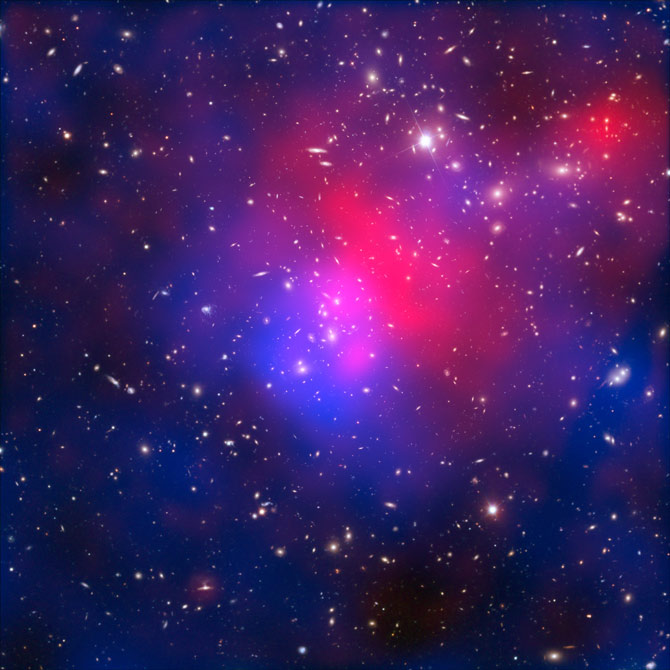A team of scientists studying the galaxy cluster Abell 2744, nicknamed Pandora’s Cluster, have pieced together a likely scenario of the cluster’s complex and violent history using telescopes in space and on the ground, including the Hubble Space Telescope, the European Southern Observatory’s Very Large Telescope (VLT), the Japanese Subaru telescope, and NASA’s Chandra X-ray Observatory.

The giant galaxy cluster appears to be the result of a pile-up of at least four separate, smaller galaxy clusters. The crash took place over a span of 350 million years.
The galaxies in the cluster make up less than five percent of its mass. The gas (around 20 percent) is so hot that it shines only in X-rays (colored red in this image). The distribution of invisible dark matter (making up around 75 percent of the cluster’s mass) is colored here in blue.
Dark matter does not emit, absorb, or reflect light, but it makes itself apparent through gravitational attraction. To pinpoint the location of this elusive substance the team exploited a phenomenon known as gravitational lensing. This is the bending of light rays from distant galaxies as they pass through the gravitational field created by the cluster. The result is a series of telltale distortions in the images of galaxies in the background of the Hubble and VLT observations. By carefully analyzing the way these images are distorted, it is possible to accurately map where the dark matter lies.
Chandra mapped the distribution of hot gas in the cluster. The data suggest that the complex collision has separated out some of the hot gas (which interacts upon collision) and the dark matter (which does not) so that they now lie apart from each other and from the visible galaxies. Near the core of the cluster there is a “bullet” shape where the gas of one cluster collided with that of another to create a shock wave. The dark matter passed through the collision unaffected.
In another part of Pandora’s cluster, galaxies and dark matter are evident, but no hot gas. The gas may have been stripped away during the collision, leaving behind no more than a faint trail.
Bottom line: Astronomers used the Hubble Space Telescope, the European Southern Observatory’s Very Large Telescope (VLT), the Japanese Subaru telescope, and NASA’s Chandra X-ray Observatory — along with gravitational lensing — to map out the interaction of gas and dark matter in Pandora’s cluster (galaxy cluster Abell 2744) and piece together its history.











